高中英语外研版(2019)选择性必修第二册 Unit 6 Survival Understanding ideas the wild within课件(共18张PPT)
文档属性
| 名称 | 高中英语外研版(2019)选择性必修第二册 Unit 6 Survival Understanding ideas the wild within课件(共18张PPT) | 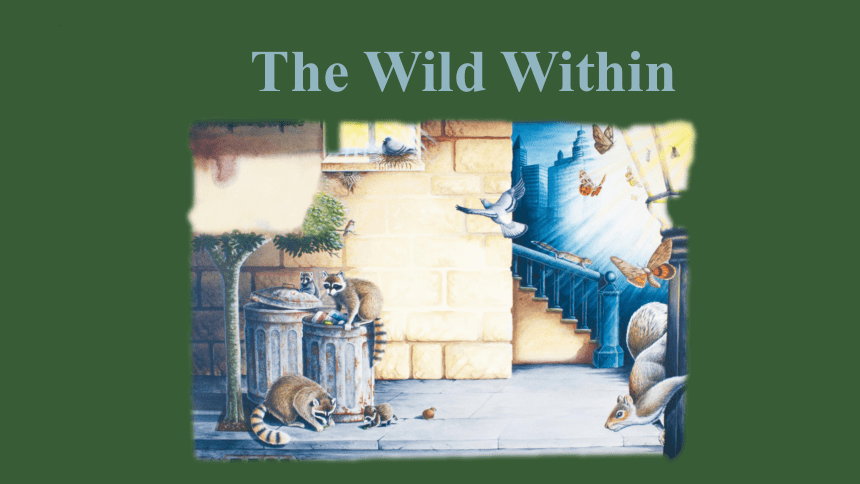 | |
| 格式 | zip | ||
| 文件大小 | 7.2MB | ||
| 资源类型 | 教案 | ||
| 版本资源 | 外研版(2019) | ||
| 科目 | 英语 | ||
| 更新时间 | 2022-07-07 07:04:21 | ||
图片预览

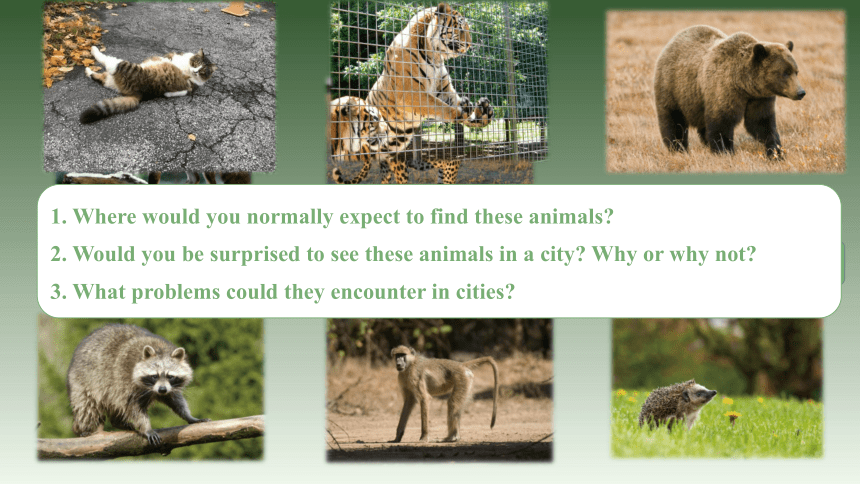
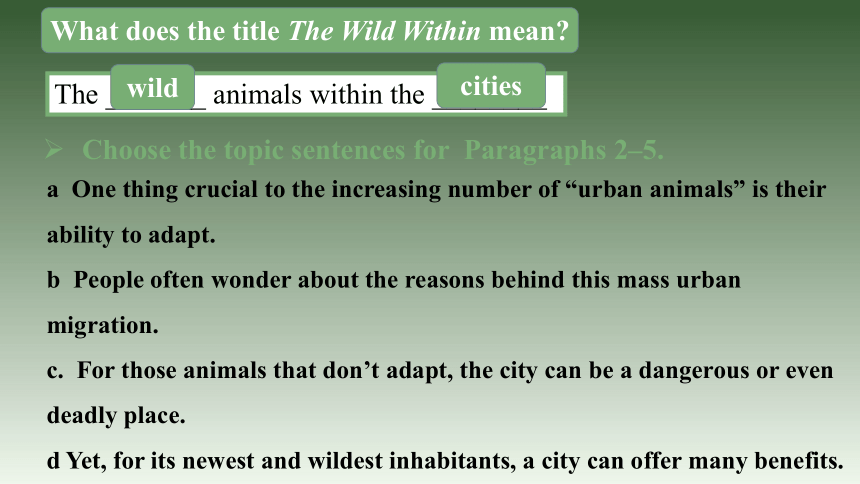
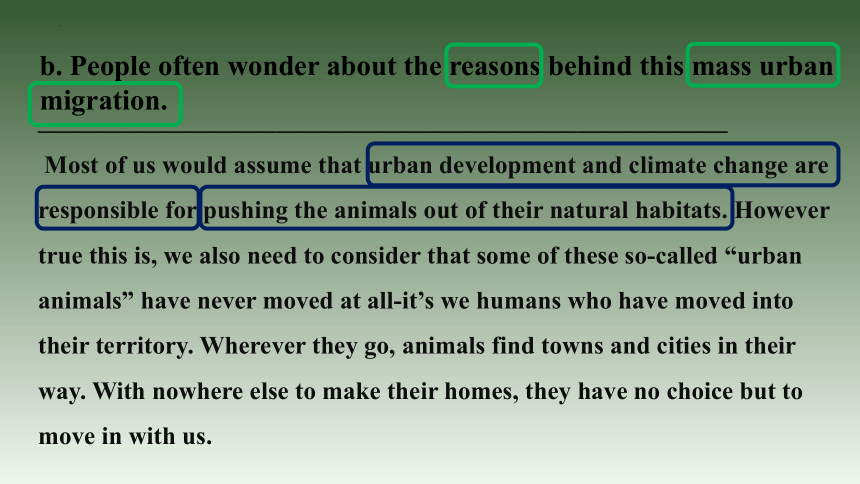
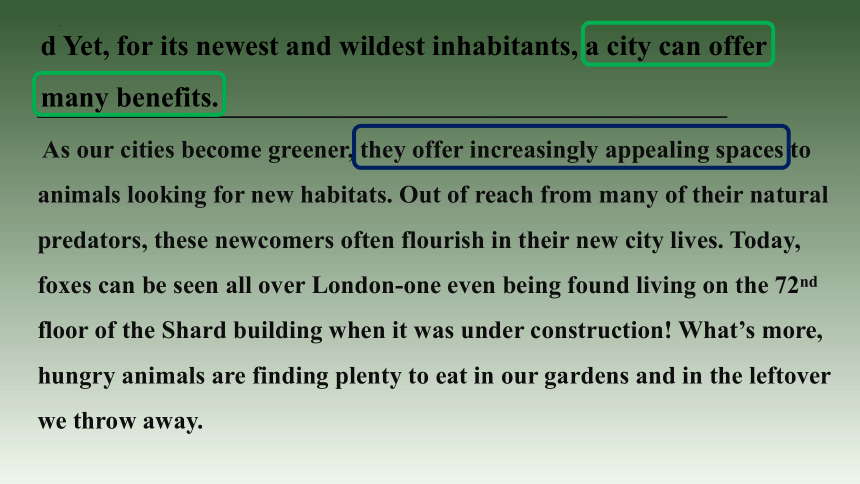
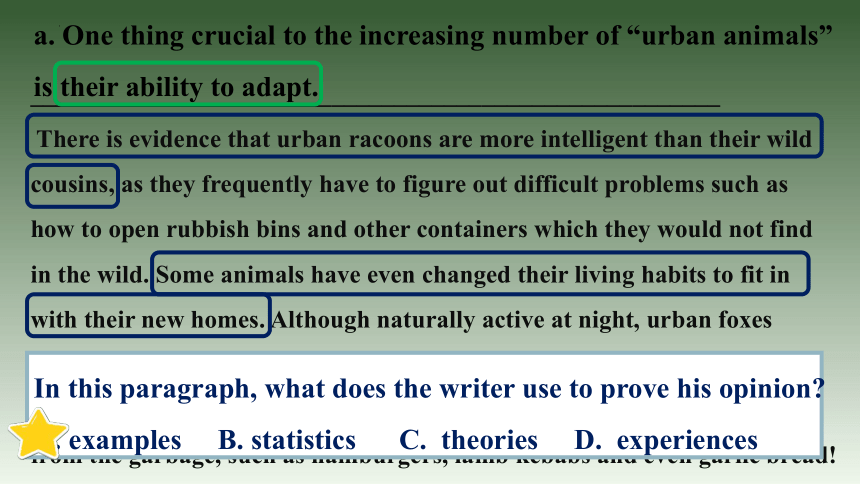
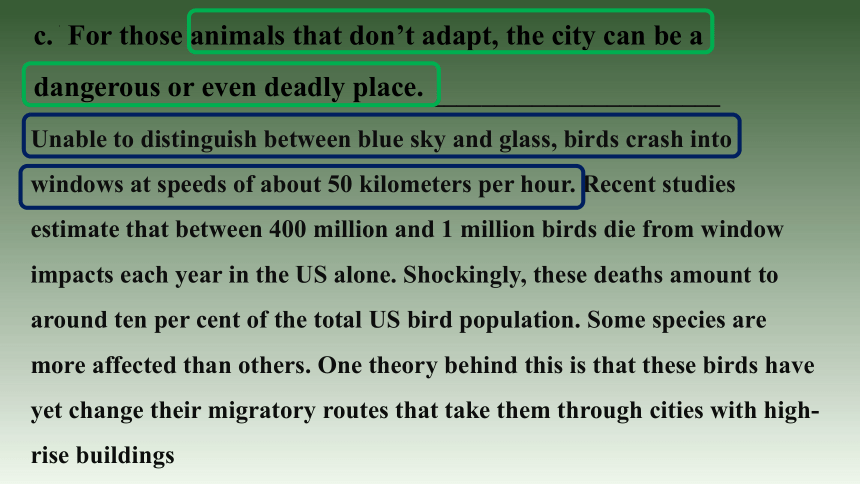
文档简介
(共18张PPT)
The Wild Within
fox
leopard
racoon
chacma baboon
hedgehog
刺猬
1. Where would you normally expect to find these animals
2. Would you be surprised to see these animals in a city Why or why not
3. What problems could they encounter in cities
What does the title The Wild Within mean
The _______ animals within the ________
wild
cities
a One thing crucial to the increasing number of “urban animals” is their ability to adapt.
b People often wonder about the reasons behind this mass urban migration.
c. For those animals that don’t adapt, the city can be a dangerous or even deadly place.
d Yet, for its newest and wildest inhabitants, a city can offer many benefits.
Choose the topic sentences for Paragraphs 2–5.
_______________________________________________________
Most of us would assume that urban development and climate change are responsible for pushing the animals out of their natural habitats. However true this is, we also need to consider that some of these so-called “urban animals” have never moved at all-it’s we humans who have moved into their territory. Wherever they go, animals find towns and cities in their way. With nowhere else to make their homes, they have no choice but to move in with us.
b. People often wonder about the reasons behind this mass urban migration.
_______________________________________________________
As our cities become greener, they offer increasingly appealing spaces to animals looking for new habitats. Out of reach from many of their natural predators, these newcomers often flourish in their new city lives. Today, foxes can be seen all over London-one even being found living on the 72nd floor of the Shard building when it was under construction! What’s more, hungry animals are finding plenty to eat in our gardens and in the leftover we throw away.
d Yet, for its newest and wildest inhabitants, a city can offer many benefits.
_______________________________________________________
There is evidence that urban racoons are more intelligent than their wild cousins, as they frequently have to figure out difficult problems such as how to open rubbish bins and other containers which they would not find in the wild. Some animals have even changed their living habits to fit in with their new homes. Although naturally active at night, urban foxes come out in daylight if the reward is good enough. Their city location also means that they are getting a taste for the multicultural cuisine on offer from the garbage, such as hamburgers, lamb kebabs and even garlic bread!
a. One thing crucial to the increasing number of “urban animals” is their ability to adapt.
In this paragraph, what does the writer use to prove his opinion
A. examples B. statistics C. theories D. experiences
_______________________________________________________
Unable to distinguish between blue sky and glass, birds crash into windows at speeds of about 50 kilometers per hour. Recent studies estimate that between 400 million and 1 million birds die from window impacts each year in the US alone. Shockingly, these deaths amount to around ten per cent of the total US bird population. Some species are more affected than others. One theory behind this is that these birds have yet change their migratory routes that take them through cities with high-rise buildings
c. For those animals that don’t adapt, the city can be a dangerous or even deadly place.
More and more wild animals are entering cities
phenomenon
Reasons for migration
Benefits of cities for animals
Animals’ adaption to cities
Dangers for animals
We should learn to better understand and appreciate our wild neighbours, and _______________
conclusion
Para 1
Para 2
Para 3
Para 4
Para 5
Para 6
Mass urban migration
Complete the mindmap
The crime took place in a seaside suburb of Cape Town. Spotting the car with its window left open, the greedy thief didn’t hesitate. Within seconds, he had reached inside and run away with a bag of shopping. No matter how many crimes he committed, the police were powerless to arrest him. You see, this was no ordinary criminal: it was a chacma baboon. Once almost unheard of, scenes like this one in Cape Town are now common all over the world. With foxes in London, mountain lions in San Francisco and wild pigs in Hong Kong, it is almost as if our cities are being taken over by wild animals.
The crime took place in a seaside suburb of Cape Town. Spotting the car with its window left open, the greedy thief didn’t hesitate. Within seconds, he had reached inside and run away with a bag of shopping. No matter how many crimes he committed, the police were powerless to arrest him. You see, this was no ordinary criminal: it was a chacma baboon. Once almost unheard of, scenes like this one in Cape Town are now common all over the world. With foxes in London, mountain lions in San Francisco and wild pigs in Hong Kong, it is almost as if our cities are being taken over by wild animals.
a port city in southwestern South Africa
Which figure of speech(修辞手法) is used here
Is it typical
Personification
拟人
a chacma baboon in Cape Town
a fox in London
a mountain lion in San Francisco
a wild pig in Hong Kong
What conclusion does the author draw from these scenes
Reasons for migration
People often wonder about the reasons behind
this mass urban migration. Most of us would assume that urban development and climate change are responsible for pushing the animals out of their natural habitats. However true this is, we also need to consider that some of these so-called “urban animals” have never moved at all-it’s we humans who have moved into their territory. Wherever they go, animals find towns and cities in their way. With nowhere else to make their homes, they have no choice but to move in with us.
___________ development and ___________ change
_________ are newcomers to their territory, who made animals ___________
urban
climate
humans
homeless
Benefits of cities
______________ spaces as habitats
Away from natural __________
Plenty of food in _________ and _________
appealing
predators
gardens
leftover
Animals’ adaption
One thing crucial to the increasing number of “urban animals” is their ability to adapt. There is evidence that urban racoons are more intelligent than their wild cousins, as they frequently have to figure out difficult problems such as how to open rubbish bins and other containers which they would not find in the wild.
Urban animals are more _________
than their wild cousins.
Some animals have even changed their —____________ to fit in with their new homes.
intelligent
Some animals have even changed their living habits to fit in with their new homes. Although naturally active at night, urban foxes come out in daylight if the reward is good enough. Their city location also means that they are getting a taste for the multicultural cuisine on offer from the garbage, such as hamburgers, lamb kebabs and even garlic bread!
Animals’ adaption
Urban animals are more _________
than their wild cousins.
Some animals have even changed their ____________ to fit in with their new homes.
living habits
Is every species able to adapt to cities
For those animals that don’t adapt, the city can be a dangerous or even deadly place. Unable to distinguish between blue sky and glass, birds crash into windows at speeds of about 50 kilometers per hour. Recent studies estimate that between 400 million and 1 million birds die from window impacts each year in the US alone. Shockingly, these deaths amount to around ten per cent of the total US bird population. Some species are more affected than others. One theory behind this is that these birds have yet change their migratory routes that take them through cities with high-rise buildings
v
What happened to birds
What caused it
Conclusion
We should learn to better understand and
_____________our wild neighbours, and look towards ____________________our urban habitats
appreciate
harmoniously sharing
However they adapt to our ways of urban living, it’s important that we get a better understanding of and even learn to
appreciate our wild neighbours. Only then can we
look towards harmoniously sharing our urban
habitats. Whatever the reasons behind these species
entering our cities, one thing is for sure-as it’s often a
means of their survival, they could be with us to stay
Think and share
Conduct an interview with a naturalist about “The Wild Within”.
What’s the relationship between people and urban animals
What should people do to protect urban animals
What’s the future of urban animals
Should we restrict urban development
The Wild Within
fox
leopard
racoon
chacma baboon
hedgehog
刺猬
1. Where would you normally expect to find these animals
2. Would you be surprised to see these animals in a city Why or why not
3. What problems could they encounter in cities
What does the title The Wild Within mean
The _______ animals within the ________
wild
cities
a One thing crucial to the increasing number of “urban animals” is their ability to adapt.
b People often wonder about the reasons behind this mass urban migration.
c. For those animals that don’t adapt, the city can be a dangerous or even deadly place.
d Yet, for its newest and wildest inhabitants, a city can offer many benefits.
Choose the topic sentences for Paragraphs 2–5.
_______________________________________________________
Most of us would assume that urban development and climate change are responsible for pushing the animals out of their natural habitats. However true this is, we also need to consider that some of these so-called “urban animals” have never moved at all-it’s we humans who have moved into their territory. Wherever they go, animals find towns and cities in their way. With nowhere else to make their homes, they have no choice but to move in with us.
b. People often wonder about the reasons behind this mass urban migration.
_______________________________________________________
As our cities become greener, they offer increasingly appealing spaces to animals looking for new habitats. Out of reach from many of their natural predators, these newcomers often flourish in their new city lives. Today, foxes can be seen all over London-one even being found living on the 72nd floor of the Shard building when it was under construction! What’s more, hungry animals are finding plenty to eat in our gardens and in the leftover we throw away.
d Yet, for its newest and wildest inhabitants, a city can offer many benefits.
_______________________________________________________
There is evidence that urban racoons are more intelligent than their wild cousins, as they frequently have to figure out difficult problems such as how to open rubbish bins and other containers which they would not find in the wild. Some animals have even changed their living habits to fit in with their new homes. Although naturally active at night, urban foxes come out in daylight if the reward is good enough. Their city location also means that they are getting a taste for the multicultural cuisine on offer from the garbage, such as hamburgers, lamb kebabs and even garlic bread!
a. One thing crucial to the increasing number of “urban animals” is their ability to adapt.
In this paragraph, what does the writer use to prove his opinion
A. examples B. statistics C. theories D. experiences
_______________________________________________________
Unable to distinguish between blue sky and glass, birds crash into windows at speeds of about 50 kilometers per hour. Recent studies estimate that between 400 million and 1 million birds die from window impacts each year in the US alone. Shockingly, these deaths amount to around ten per cent of the total US bird population. Some species are more affected than others. One theory behind this is that these birds have yet change their migratory routes that take them through cities with high-rise buildings
c. For those animals that don’t adapt, the city can be a dangerous or even deadly place.
More and more wild animals are entering cities
phenomenon
Reasons for migration
Benefits of cities for animals
Animals’ adaption to cities
Dangers for animals
We should learn to better understand and appreciate our wild neighbours, and _______________
conclusion
Para 1
Para 2
Para 3
Para 4
Para 5
Para 6
Mass urban migration
Complete the mindmap
The crime took place in a seaside suburb of Cape Town. Spotting the car with its window left open, the greedy thief didn’t hesitate. Within seconds, he had reached inside and run away with a bag of shopping. No matter how many crimes he committed, the police were powerless to arrest him. You see, this was no ordinary criminal: it was a chacma baboon. Once almost unheard of, scenes like this one in Cape Town are now common all over the world. With foxes in London, mountain lions in San Francisco and wild pigs in Hong Kong, it is almost as if our cities are being taken over by wild animals.
The crime took place in a seaside suburb of Cape Town. Spotting the car with its window left open, the greedy thief didn’t hesitate. Within seconds, he had reached inside and run away with a bag of shopping. No matter how many crimes he committed, the police were powerless to arrest him. You see, this was no ordinary criminal: it was a chacma baboon. Once almost unheard of, scenes like this one in Cape Town are now common all over the world. With foxes in London, mountain lions in San Francisco and wild pigs in Hong Kong, it is almost as if our cities are being taken over by wild animals.
a port city in southwestern South Africa
Which figure of speech(修辞手法) is used here
Is it typical
Personification
拟人
a chacma baboon in Cape Town
a fox in London
a mountain lion in San Francisco
a wild pig in Hong Kong
What conclusion does the author draw from these scenes
Reasons for migration
People often wonder about the reasons behind
this mass urban migration. Most of us would assume that urban development and climate change are responsible for pushing the animals out of their natural habitats. However true this is, we also need to consider that some of these so-called “urban animals” have never moved at all-it’s we humans who have moved into their territory. Wherever they go, animals find towns and cities in their way. With nowhere else to make their homes, they have no choice but to move in with us.
___________ development and ___________ change
_________ are newcomers to their territory, who made animals ___________
urban
climate
humans
homeless
Benefits of cities
______________ spaces as habitats
Away from natural __________
Plenty of food in _________ and _________
appealing
predators
gardens
leftover
Animals’ adaption
One thing crucial to the increasing number of “urban animals” is their ability to adapt. There is evidence that urban racoons are more intelligent than their wild cousins, as they frequently have to figure out difficult problems such as how to open rubbish bins and other containers which they would not find in the wild.
Urban animals are more _________
than their wild cousins.
Some animals have even changed their —____________ to fit in with their new homes.
intelligent
Some animals have even changed their living habits to fit in with their new homes. Although naturally active at night, urban foxes come out in daylight if the reward is good enough. Their city location also means that they are getting a taste for the multicultural cuisine on offer from the garbage, such as hamburgers, lamb kebabs and even garlic bread!
Animals’ adaption
Urban animals are more _________
than their wild cousins.
Some animals have even changed their ____________ to fit in with their new homes.
living habits
Is every species able to adapt to cities
For those animals that don’t adapt, the city can be a dangerous or even deadly place. Unable to distinguish between blue sky and glass, birds crash into windows at speeds of about 50 kilometers per hour. Recent studies estimate that between 400 million and 1 million birds die from window impacts each year in the US alone. Shockingly, these deaths amount to around ten per cent of the total US bird population. Some species are more affected than others. One theory behind this is that these birds have yet change their migratory routes that take them through cities with high-rise buildings
v
What happened to birds
What caused it
Conclusion
We should learn to better understand and
_____________our wild neighbours, and look towards ____________________our urban habitats
appreciate
harmoniously sharing
However they adapt to our ways of urban living, it’s important that we get a better understanding of and even learn to
appreciate our wild neighbours. Only then can we
look towards harmoniously sharing our urban
habitats. Whatever the reasons behind these species
entering our cities, one thing is for sure-as it’s often a
means of their survival, they could be with us to stay
Think and share
Conduct an interview with a naturalist about “The Wild Within”.
What’s the relationship between people and urban animals
What should people do to protect urban animals
What’s the future of urban animals
Should we restrict urban development
